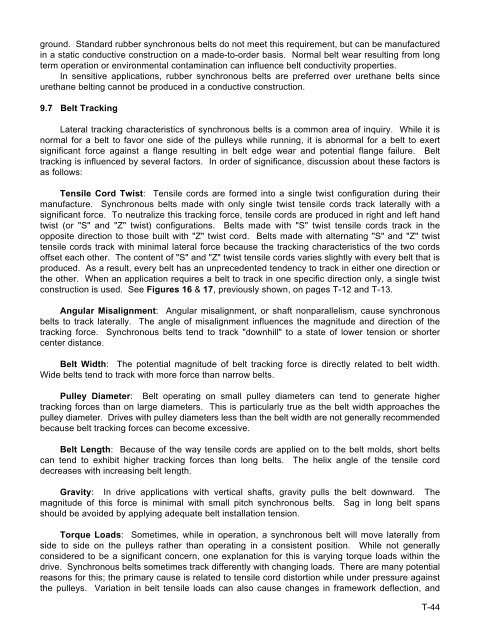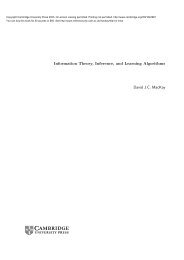THE WORLD OF TIMING BELTS - MAELabs UCSD
THE WORLD OF TIMING BELTS - MAELabs UCSD
THE WORLD OF TIMING BELTS - MAELabs UCSD
Create successful ePaper yourself
Turn your PDF publications into a flip-book with our unique Google optimized e-Paper software.
ground. Standard rubber synchronous belts do not meet this requirement, but can be manufactured<br />
in a static conductive construction on a made-to-order basis. Normal belt wear resulting from long<br />
term operation or environmental contamination can influence belt conductivity properties.<br />
In sensitive applications, rubber synchronous belts are preferred over urethane belts since<br />
urethane belting cannot be produced in a conductive construction.<br />
9.7 Belt Tracking<br />
Lateral tracking characteristics of synchronous belts is a common area of inquiry. While it is<br />
normal for a belt to favor one side of the pulleys while running, it is abnormal for a belt to exert<br />
significant force against a flange resulting in belt edge wear and potential flange failure. Belt<br />
tracking is influenced by several factors. In order of significance, discussion about these factors is<br />
as follows:<br />
Tensile Cord Twist: Tensile cords are formed into a single twist configuration during their<br />
manufacture. Synchronous belts made with only single twist tensile cords track laterally with a<br />
significant force. To neutralize this tracking force, tensile cords are produced in right and left hand<br />
twist (or "S" and "Z" twist) configurations. Belts made with "S" twist tensile cords track in the<br />
opposite direction to those built with "Z" twist cord. Belts made with alternating "S" and "Z" twist<br />
tensile cords track with minimal lateral force because the tracking characteristics of the two cords<br />
offset each other. The content of "S" and "Z" twist tensile cords varies slightly with every belt that is<br />
produced. As a result, every belt has an unprecedented tendency to track in either one direction or<br />
the other. When an application requires a belt to track in one specific direction only, a single twist<br />
construction is used. See Figures 16 & 17, previously shown, on pages T-12 and T-13.<br />
Angular Misalignment: Angular misalignment, or shaft nonparallelism, cause synchronous<br />
belts to track laterally. The angle of misalignment influences the magnitude and direction of the<br />
tracking force. Synchronous belts tend to track "downhill" to a state of lower tension or shorter<br />
center distance.<br />
Belt Width: The potential magnitude of belt tracking force is directly related to belt width.<br />
Wide belts tend to track with more force than narrow belts.<br />
Pulley Diameter: Belt operating on small pulley diameters can tend to generate higher<br />
tracking forces than on large diameters. This is particularly true as the belt width approaches the<br />
pulley diameter. Drives with pulley diameters less than the belt width are not generally recommended<br />
because belt tracking forces can become excessive.<br />
Belt Length: Because of the way tensile cords are applied on to the belt molds, short belts<br />
can tend to exhibit higher tracking forces than long belts. The helix angle of the tensile cord<br />
decreases with increasing belt length.<br />
Gravity: In drive applications with vertical shafts, gravity pulls the belt downward. The<br />
magnitude of this force is minimal with small pitch synchronous belts. Sag in long belt spans<br />
should be avoided by applying adequate belt installation tension.<br />
Torque Loads: Sometimes, while in operation, a synchronous belt will move laterally from<br />
side to side on the pulleys rather than operating in a consistent position. While not generally<br />
considered to be a significant concern, one explanation for this is varying torque loads within the<br />
drive. Synchronous belts sometimes track differently with changing loads. There are many potential<br />
reasons for this; the primary cause is related to tensile cord distortion while under pressure against<br />
the pulleys. Variation in belt tensile loads can also cause changes in framework deflection, and<br />
T-44
















